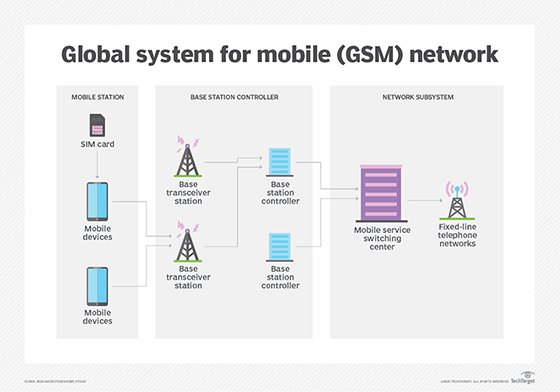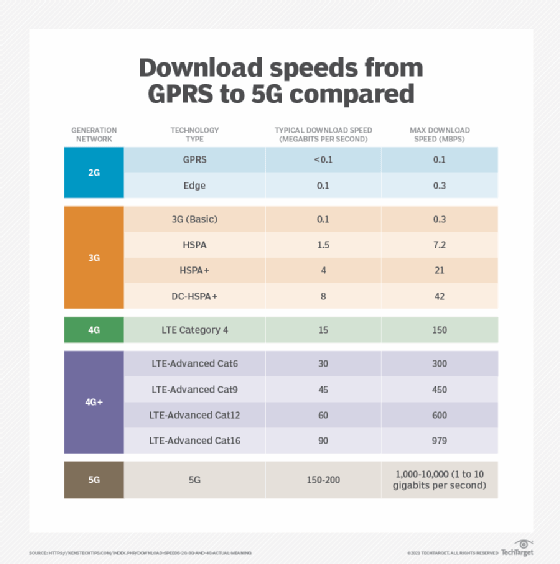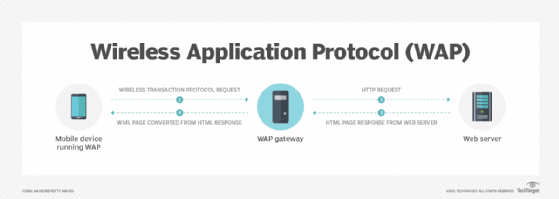GPRS (General Packet Radio Service)
What is GPRS (General Packet Radio Service)?
GPRS (General Packet Radio Service) is a best-effort packet-switching protocol and standard for wireless and cellular network communication services. GPRS is used to transport data over 2G, 3G and Wideband Code Division Multiple Access mobile networks at moderate speeds.
The 3rd Generation Partnership Project (3GPP) standardized GPRS in early 1998, but commercial cellular networks did not widely adopt the technology until 2000. It was the first technology successfully deployed in 2G mobile phone systems.
GPRS is considered best effort because all packets are given the same priority and the delivery of packets isn't guaranteed.
GPRS uses an always-online function, which enables users to connect to different internet- and data-based services. With GPRS, mobile users can access mobile internet browsing, email, broadcasting, Short Message Service (SMS) and Multimedia Messaging Service (MMS). GPRS was one of the first widely accessible data transfer protocols used on cellular networks.
Even though it is not used as often, GPRS is still relevant today, as it is widely compatible with networks and mobile devices. Countries like Canada, China and Switzerland still use 2G and 3G networks -- all with plans to sunset the technology within the next few years. All major carriers in the United States no longer offer 2G or 3G services, and other countries like Japan have also retired the technologies.

How GPRS works
What made GPRS technology different from other cellular wireless technologies at the time, like Global System for Mobile Communications (GSM), was the use of packet-switched data instead of the traditional circuit-switched data. When a cellphone was on circuit-switched mode, the circuit was permanently switched on to a specific user. By contrast, packet-switched data transfers occurred in bursts during short peaks, followed by breaks.
This approach was a more efficient use of available capacity because, by splitting data into packets and tags, GPRS shared overall capacity among multiple users. This was possible because everyone wasn't often online at the same time. The destination address became available when inserted into the packet, which enabled packets from multiple sources to transmit through a single link.
The speeds of GPRS range from around 40 to 115 kilobits per second (Kbps). By comparison, 4G Long-Term Evolution speeds reach around 100 megabits per second, 4G reaches 1,000 Mbps and 5G speeds can reach to around 10 gigabits per second.

Difference between GSM and GPRS
GSM and GPRS are both protocols and standards designed for use on mobile networks. GPRS, however, is an improved version of GSM.
The primary difference between GSM and GPRS is that GSM is a circuit-switching system, while GPRS is a packet-switching system. GPRS offers more data transmission options for GSM-based devices, as GSM networks at the time could only use SMS, for example, to transmit a small amount of data.
With GPRS technology, mobile devices could support data functions across cellular internet connections. GPRS revolutionized GSM by providing real data capability and enabling emails and simple web browsing -- albeit at speeds much slower than the current standard.
Sometimes called a 2.5G network, GPRS provided data rates from about 56 to 115 Kbps and uninterrupted connectivity to the internet for mobile phones and computers. By comparison, GSM provided data rates of around 9.6 Kbps. However, GPRS by itself did not offer the mechanisms required to browse the internet. To enable seamless internet access, Wireless Application Protocol (WAP) was needed. It emerged in 1999.
The key characteristics of GPRS are quick, for the time, data connections -- depending on the signal strength and coverage -- and the facilitation of mobile application development. So, GPRS enabled capabilities such as file transfer; online chat; and mobile, web and multimedia applications, as well as video conferencing platforms, on mobile devices and laptop computers.

GPRS performance classes
The industry classifies GPRS mobile networks by the number of slots they can accommodate. Multislot classes -- from 1 to 45 -- determine the speed of uplink and downlink voice and data transfer. As levels of operation and capability vary, a good indicator of a device's service ability is its GPRS performance class. GPRS has three classes based on the ability to connect GSM and GPRS services.
The three classifications are as follows:
- Class A. Can connect to both GSM and GPRS services concurrently.
- Class B. Can connect to both GSM and GPRS services but not simultaneously.
- Class C. Can use either GPRS or GSM services, but the user must switch between the two manually.
GPRS data speeds depend on the number of time slots available for use in either direction. These slots send and receive data, uplink or downlink. GPRS also uses channel encoding processes called cyclic code and convolutional code, the latter of which is a type of error-correcting code.
Difference between GPS and GPRS
Although the acronyms sound similar, GPS (Global Positioning System) and GPRS are not the same. GPRS helps cellular companies offer data and internet services, and GPS provides location data.
GPS is a satellite-based navigation system powered by approximately 31 satellite systems in orbit owned and operated by the U.S. Department of Defense but available for general use worldwide. It enables GPS receivers, including consumer devices, like smartphone navigation systems, to pinpoint their geographic location. GPRS, on the other hand, is based on GSM and other services, such as SMS, MMS and circuit-switched cellular phone connections.
Advantages of GPRS
Advantages of GPRS compared to previous GMS-enabled systems include the following:
- Increased speeds. GPRS provides higher data rates than GMS. GPRS provides speeds from about 40 to 115 Kbps, versus GMS, which provides speeds up to 9.6 Kbps.
- Online services. Mobile users can access online services, such as internet browsing and email, as well as SMS and MMS.
- Always on. A GPRS connection provides constant internet connectivity, which enables quick messaging and improved internet services.
- Billing. GPRS packet transfer offers better billing options for consumers when compared to circuit-switched GMS services.
GPRS was considered groundbreaking when it was first released, as it was one of the first considerable steps toward high-speed internet for mobile devices.
Challenges of GPRS
Challenges related to GPRS include the following:
- Dated technology. GPRS is used on 2G and 3G mobile networks, which are slowly being phased out of use.
- Difficulty reaching maximum speed. In order to reach GPRS' maximum possible data rate, a user needs access to all eight available timeslots, which is unlikely to happen.
- Not ideal for modern data-intensive applications. Today, GPRS is adequate for slow, less data-intensive data transfers. However, the technology is not fit for more modern data-intensive applications.
History of GPRS
Telecommunications systems used circuit-switching technology for decades before transitioning to the data-centric model prevalent today.
GPRS was first standardized by 3GPP in early 1998, but it wasn't widely adopted by commercial cellular networks until 2000.
In theory, GPRS packet-based services cost users less than circuit-switched services since communication channels are being utilized on a shared-use, as-packets-are-needed basis rather than dedicated to only one user at a time. It was also easier to make applications available to mobile users because of the faster data rate. As GPRS became more widely available, along with other 2.5G and 3G services, mobile users of virtual private networks (VPNs) were able to access the private network continuously over wireless rather than through a rooted dial-up connection.
With the emergence of Enhanced Data rates for GSM Evolution (EDGE) mobile handsets, the first smartphones from the likes of BlackBerry, Nokia and Palm laid the foundation for today's wireless data-based ecosystem. 2G GPRS data usage rapidly evolved the wireless industry to become more centered on data communication, rather than voice.
As a result, GPRS became widely available across mobile services and users of VPNs. Compatibility with Bluetooth, a standard protocol for replacing wired connections between devices with wireless radio connections, and X.25, a packet-based protocol primarily used in Europe, helped drive adoption.
The evolution of GSM with GPRS and the emergence of EDGE and Universal Mobile Telecommunications System also helped cement cellular data technology's place in global communications.
Despite being slower than the technology that came after it, GPRS remained in use for a long time. The end of GPRS is in sight, though, as newer technologies, like 4G (introduced in 2009) and 5G (introduced in 2018), have begun phasing out the relevance of 2G and 3G in most countries. 2G and 3G services -- and, therefore, GPRS -- are slowly being phased out. Still, GPRS remains an important part of mobile communications history.
The four types of wireless networks -- wireless local area network, wireless metropolitan area network, wireless personal area network and wireless wide area network -- differ when it comes to size, range and connectivity requirements. Learn about the different types of wireless networks.






